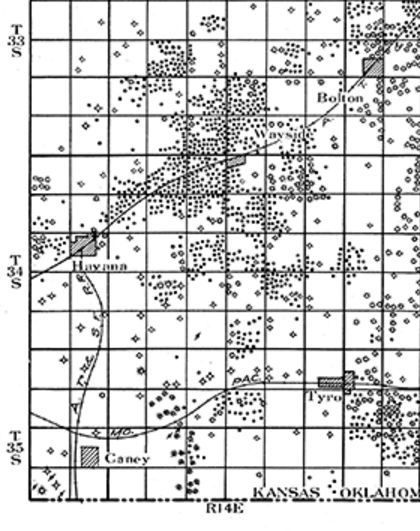Havana began as a general store in southeastern Kansas in 1870. The state’s first natural gas well was drilled nearby three years later. The Atchison, Topeka and Santa Fe Railway reached the town in 1886, but oil discoveries in 1892 were the most significant events in Havana and Montomery County – at least until the Dalton Gang’s last raid on Coffeyville banks two years later.
Also in 1894, the natural gas wells at Coffeyville were blamed for a massive explosion – a “volcanic upheaval” – in the business district of that city, according to History of Montgomery County, Kansas. A natural gas drilling boom had begun earlier, with “nearly five hundred farm houses in the county supplied by this ideal fuel.
The natural gas fields around Havana (named after Havana, Illinois) would continue to challenge technologies of the day. Another Montgomery County town made national headlines in 1906 when lightning ignited a natural gas well. The flaming gas well of Caney towered 150 feet high and could be seen for 35 miles at night.
The first oil discovery in Indian Territory in 1897 had brought more drilling companies to Havana and Montgomery County. Harry Sinclair, who grew up in the county seat of Independence, got his start in the business by selling lumber for derricks in southeastern Kansas oilfields. He would create a major oil company with the help of a petroleum marketing dinosaur,
 Not as fortunate was James M. Parker, who was president of the Havana Oil Company from about 1904 to 1907. The newcomer was also general manager of the Vulcan Oil Company, also known as Vulcan Oil & Gas Company, “and other interests in the Kansas fields,” according to a contemporary account in Paint, Oil and Chemical Review.
Not as fortunate was James M. Parker, who was president of the Havana Oil Company from about 1904 to 1907. The newcomer was also general manager of the Vulcan Oil Company, also known as Vulcan Oil & Gas Company, “and other interests in the Kansas fields,” according to a contemporary account in Paint, Oil and Chemical Review.
Parker impressed editors at the Topeka Daily Capital.
“Mr. Parker came to Kansas a year ago without any knowledge of the oil business,” the newspaper noted in 1904. “He secured large blocks of leases and has met with exceptional success, and is today recognized as one of the best informed men in the field.”
Parker had come from Colorado Springs, Colorado, with a background in civil engineering “and his early training in exactness is evident in all his work.” Havana Oil Company’s principal investors were Easterners from Syracuse and Hamilton, New York.
Parker was one of the original members of the Western Oil Producers’ Association, an alliance which formed in 1904 to “by all honorable means protect and defend the industry against aggressions of monopolistic transporters, refiners and buyers.”
Rockefeller’s Standard Oil Company was the villain, having just been pilloried by Ida Tarbell’s 1904 publication of The History of the Standard Oil Company.
Whether on behalf of Vulcan Oil or Havana Oil, Parker acquired a 240-acre lease with nine producing wells in 1904. He was reported by United States Investor in March 25, 1905, to be, one of the leaders in the fight against Standard Oil in Kansas.
“He is regarded as capable and energetic and has personal references of a satisfactory character,” noted the Investor. “He is classified as a promoter, but has been successful. The leases above referred to are all in excellent condition, well equipped, and the property, with a market for oil, should be worth, it is said, at least. $200,000.”
In 1905 and 1906, Parker’s annual stockholders meetings were held in Phoenix, Arizona. Newspapers noted about this time that Parker had become president of the Rutland Oil Company as well.
But in 1907, stockholders’ meetings for both Vulcan Oil & Gas and Havana Oil Company were no longer held in Phoenix. The next meetings were advertised to be in Havana, where this part of the Kansas oil boom continued around the Santa Fe railroad tracks between the towns of Wayside and Havana, southwest of Independence.
Although Havana Oil reportedly had several producing wells and infrastructure in the Wayside district, it disappeared into petroleum history after 1907.
___________________________________________________________________________________
The stories of exploration and production companies trying to join petroleum booms (and avoid busts) can be found updated in Is my Old Oil Stock worth Anything? The American Oil & Gas Historical Society preserves U.S. petroleum history. Please support this AOGHS.ORG energy education website. For membership information, contact bawells@aoghs.org. © 2018 Bruce A. Wells.
___________________________________________________________________________________

